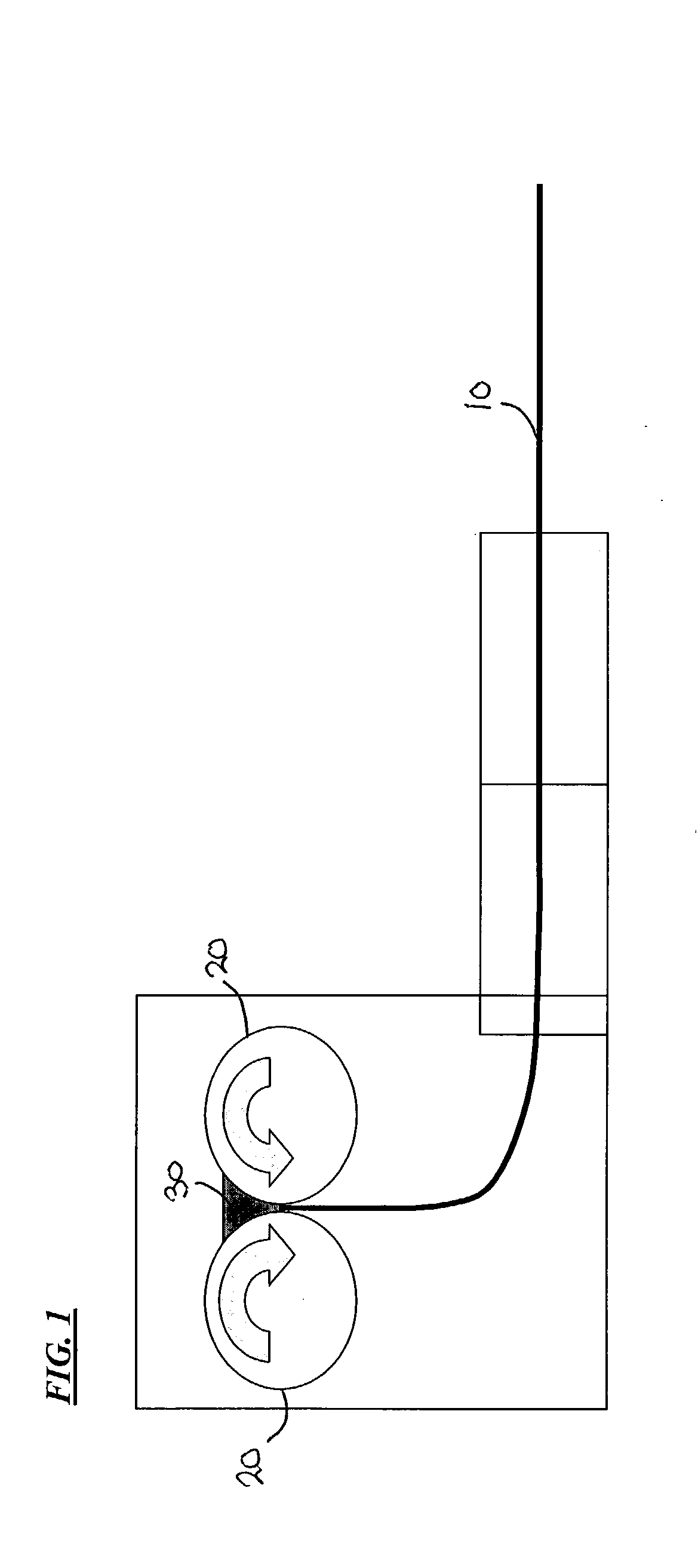Method of continuous casting non-oriented electrical steel strip
- Summary
- Abstract
- Description
- Claims
- Application Information
AI Technical Summary
Benefits of technology
Problems solved by technology
Method used
Image
Examples
example 1
[0105] Heats A and B having the compositions shown in Table I were melted, cast into strips having a thickness of about 0.10 inch (about 2.5 mm) and processed as exemplified in FIG. 2. Cast strips from Melts A having a thickness of about 0.10 inch (about 2.5 mm) and cast strips of Heat B having a thickness of about 0.10 inch (about 2.5 mm), about 0.060 inch (about 1.5 mm) and about 0.045 inch (about 1.15 mm) were provided with a hot reduction of about 30% to about 65% to a thickness of less than 0.040" (about 1 mm), the hot reduction made in a single rolling pass using about 9.5 inch (about 24 mm) diameter work rolls and a rolling speed of about 32 RPM, from a temperature below T.sub.20 as defined in Equation II. The cast and hot rolled strips were descaled, sheared into test samples and final annealed in a batch anneal at about 1550.degree. F. (about 843.degree. C.) for a soak time of about 60 minutes in an atmosphere of 80% nitrogen and 20% hydrogen with a dew point of about 75.de...
example 2
[0107] Melts A and B of Example 1 were processed in a different embodiment of the method of the present invention whereby the cast strips were processed as exemplified in FIG. 3. As shown in Table I, the composition of Melts A and B provide a volume resistivity (.rho.) calculated from Equation I representative of an intermediate-silicon non-oriented electrical steel of the art. The cast and solidified strips were subjected to rapid secondary cooling to a temperature below about 1000.degree. F. (about 540.degree. C.) in accordance with the preferred method of the present invention. The cast, solidified and cooled strips were cold rolled to a thickness of about 0.018 inch (about 0.45 mm). After cold rolling, the strips were finish annealed by batch annealing at a temperature of about 1550.degree. F. (about 843.degree. C.) for a soak time of about 60 minutes in an atmosphere of 80% nitrogen and 20% hydrogen with a dew point of about 75.degree. F. (about 25.degree. C.), or finish anneal...
example 3
[0109] Melt C shown in Table I was cast into thin strips having a thickness of either about 0.8 inch (about 2.0 mm) or about 0.10 inch (about 2.5 mm) were processed as exemplified in FIG. 4. As Table I shows, the composition of Melt C provided a volume resistivity of about 37 .mu..OMEGA.-cm, making the steel of Melt C representative of an intermediate-silicon non-oriented electrical steel of the art. The cast and solidified strips from Melt C were further subjected to rapid secondary cooling to a temperature below about 1000.degree. F. (about 540.degree. C.) strip in accordance with the preferred method of the present invention. The cast, solidified and cooled strips were reheated to a temperature of 1750.degree. F. (about 950.degree. C.) or about 2100.degree. F. (about 1150.degree. C.) in a non-oxidizing atmosphere prior to hot rolling the cast strip, the hot rolling being conducted in a single pass using about 9.5 inch (about 24 cm) diameter work rolls and a rolling speed of about...
PUM
| Property | Measurement | Unit |
|---|---|---|
| Fraction | aaaaa | aaaaa |
| Fraction | aaaaa | aaaaa |
| Fraction | aaaaa | aaaaa |
Abstract
Description
Claims
Application Information
 Login to View More
Login to View More - R&D
- Intellectual Property
- Life Sciences
- Materials
- Tech Scout
- Unparalleled Data Quality
- Higher Quality Content
- 60% Fewer Hallucinations
Browse by: Latest US Patents, China's latest patents, Technical Efficacy Thesaurus, Application Domain, Technology Topic, Popular Technical Reports.
© 2025 PatSnap. All rights reserved.Legal|Privacy policy|Modern Slavery Act Transparency Statement|Sitemap|About US| Contact US: help@patsnap.com



